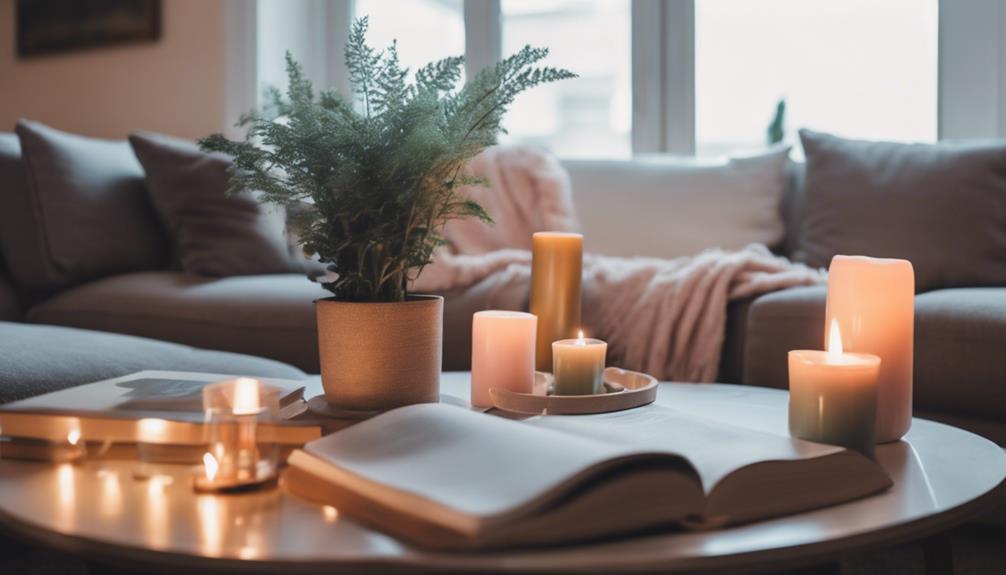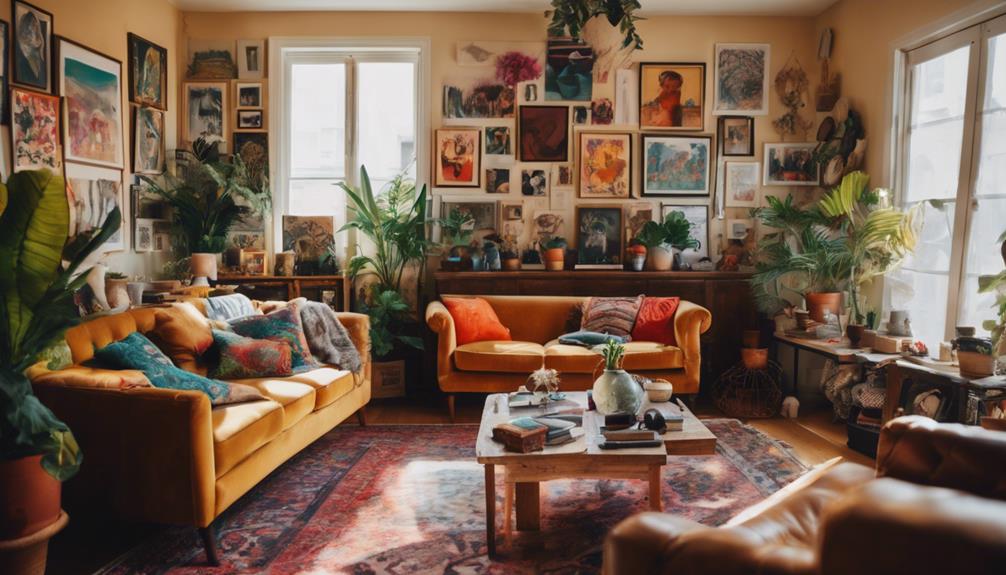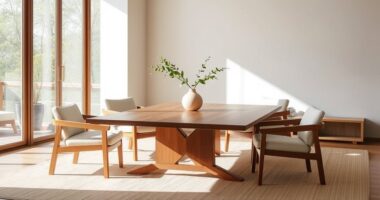When exploring academia aesthetics, you can elevate your style by embracing themes like Dark, Light, and Romantic Academia. Dark Academia embodies rich, moody colors and vintage textiles, while Light Academia uses soothing neutrals for a serene vibe. Romantic Academia leans into softer hues that evoke nostalgia. Each style features unique materials and important fixtures like antique bookshelves or vintage armchairs, enhancing the atmosphere. Lighting plays a significant role too, with options like candlelit sconces or vintage lamps creating inviting spaces. By understanding these elements, you'll find the aesthetic that resonates most with you, revealing even more fascinating options ahead.
Key Elements

When exploring academia aesthetics, you'll notice that color schemes play a pivotal role in setting the mood.
The materials and textures you choose can also enhance the overall vibe, adding depth and character to your space.
Let's break down how these elements come together to create distinct atmospheres across different styles.
Color Scheme
The color schemes in various academia aesthetics play a crucial role in shaping the mood and style, reflecting each aesthetic's distinct themes and values.
If you're drawn to the Dark Academia Aesthetic, you'll appreciate its rich palette of dark colors like deep burgundy, dark brown, and black. These shades create a mysterious and dramatic vibe, perfect for embodying themes of knowledge and melancholy.
On the other hand, if you lean towards a lighter feel, Light Academia offers a soothing array of neutral tones such as beige, caramel, and off-white. This palette promotes a serene atmosphere conducive to intellectual pursuits.
For a more whimsical touch, consider Romantic Academia, which showcases softer hues like blush pink and gold, emphasizing love and nostalgia.
Chaotic Academia brings in earthy tones like woody browns and dark blues, reflecting the beauty of a realistic and often disorganized student experience.
The color scheme you choose not only influences your wardrobe but also impacts your decor and overall lifestyle, making it an important aspect of personal expression in academia aesthetics.
Materials
Materials play an essential role in defining each academia aesthetic, shaping both the atmosphere and the experience of intellectual pursuits.
If you're drawn to dark academia fashion, you'll find that rich textiles like tweed, wool, and velvet create a moody yet sophisticated vibe. These materials often feature in clothing and accessories, enhancing the vintage appeal that dark academia embodies.
In contrast, light academia utilizes lighter materials, such as porcelain tea cups and sepia-toned notes, which foster a serene environment perfect for diving into classic literature. The juxtaposition of delicate and sturdy materials allows you to express your intellectual side while maintaining a cozy aesthetic.
Romantic academia leans into nostalgia with materials like lace doilies and fine china, evoking elegance in your academic pursuits. On the other hand, chaotic academia prefers rugged fabrics that reflect the authentic, messy nature of student life.
Art academia focuses on traditional materials like sketchbooks and vintage cameras, encouraging hands-on creativity. By understanding these materials, you can curate an aesthetic that resonates with your personal style and enhances your academic experience.
Textures
Textures significantly shape academia aesthetics, influencing how you experience the environment and interact with your studies.
In Dark Academia, you'll find heavier materials like wool and tweed that create a moody, sophisticated vibe. These textures not only add depth to your outfits but also evoke a sense of intellectualism and mystery. Layering is a common technique here, allowing you to mix different textures for a more dynamic look.
If you're drawn to Romantic Academia, delicate textures like lace and satin will appeal to your sense of femininity and elegance. These fabrics create a soft, inviting atmosphere that complements your scholarly pursuits.
On the other hand, Chaotic Academia embraces rugged and worn textures, capturing the essence of student life. Distressed fabrics and cluttered arrangements reflect a more realistic, raw approach to academia.
Lastly, Art Academia highlights an array of artistic materials—think canvas, sketch paper, and vintage leather. These textures not only serve functional purposes but also enhance the aesthetic appeal of your creative spaces.
Essential Fixtures and Furniture

When you think about essential fixtures in academia aesthetics, consider how an antique wooden bookshelf can serve as both a functional storage space and a striking visual element.
Pair that with a vintage leather armchair, and you'll create a cozy nook perfect for reading or reflection.
Adding a gothic-style candelabra can further enhance the ambiance, bringing a touch of elegance and warmth to your study area.
Antique Wooden Bookshelf
An antique wooden bookshelf adds vintage charm and elegance, making it an essential fixture in any academic space. These stunning pieces often showcase intricate carvings and unique designs that reflect craftsmanship from various historical periods, enhancing your environment's aesthetic appeal.
Whether you're curating a collection of classic literature or displaying other cherished items, this bookshelf serves as a focal point in your room. Rich woods like mahogany or oak contribute to the classic and sophisticated vibe associated with styles such as dark academia.
You'll find that an antique wooden bookshelf not only provides ample space for your books but also allows for the display of decorative items like vintage globes and framed art, enriching the overall academic atmosphere.
Investing in a well-crafted antique wooden bookshelf is a sustainable choice, as it promotes the use of reclaimed materials while supporting timeless design. By incorporating this piece into your space, you elevate your academia aesthetics and create a warm, inviting environment that inspires learning and reflection.
Vintage Leather Armchair
A vintage leather armchair complements the antique wooden bookshelf beautifully, adding warmth and sophistication to your academic space. This quintessential piece of furniture embodies classic appeal, making it a perfect choice for anyone looking to enhance their academia aesthetics. Its sturdy construction guarantees durability, while the rich patina of the leather develops a unique character over time, further elevating your environment.
Imagine sinking into the plush embrace of a vintage leather armchair while you immerse yourself in a book or ponder your next big project. The armchair's intricate detailing, like button tufting or carved wooden legs, not only enhances its aesthetic charm but also serves as a striking focal point in the room.
Creating a cozy reading nook or study area becomes effortless with this piece, inviting relaxation and intellectual pursuits. Plus, the luxurious feel of leather upholstery adds an extra layer of comfort to your academic endeavors.
Gothic-style Candelabra
Transform your academic space with a gothic-style candelabra, as its intricate designs and warm candlelight create an enchanting ambiance that perfectly complements the dark academia aesthetic.
These candelabras are characterized by ornate metalwork and twisting forms, often inspired by medieval architecture. Crafted from materials like wrought iron, brass, or silver, they can hold multiple candles, casting a dramatic glow that enhances the romantic and mysterious vibe of your surroundings.
Position a gothic-style candelabra on your desk or bookshelf to serve as a statement piece, both functional and visually striking. The historical styles reflected in these fixtures, such as Baroque or Victorian, add an elegant vintage charm to your decor, making it ideal for an academic or artistic setting.
Incorporating a candelabra not only elevates your space but also fosters a cozy atmosphere perfect for reading or writing poetry. Imagine the flickering candlelight illuminating your pages as you immerse yourself in your thoughts, surrounded by the enchanting allure of dark academia.
Embrace the moody elegance of gothic-style candelabras and watch your creativity flourish in this captivating setting.
Lighting Ideas

When you think about lighting in your academic space, consider how different fixtures can enhance your chosen aesthetic.
Chiaroscuro table lamps, candlelit wall sconces, vintage globe string lights, and antique brass chandeliers each bring a unique vibe that contributes to the overall atmosphere.
Let's explore how these lighting ideas can transform your study environment and reflect your personal style.
Chiaroscuro Table Lamps
Chiaroscuro table lamps create striking contrasts between light and shadow, enhancing both the functionality and aesthetic appeal of your academic space.
When you put together a study environment that revolves around classic literature, these lamps become essential. They often feature intricate designs in materials like carved wood or ceramic, reflecting elements of classic art movements. The warm, soft light they emit fosters a cozy atmosphere, perfect for long reading sessions or late-night study marathons.
Candlelit Wall Sconces
Candlelit wall sconces beautifully complement the warm ambiance created by chiaroscuro table lamps, enhancing the vintage charm of your academic space. These sconces add a cozy, inviting glow, making them ideal for styles like Dark Academia and Romantic Academia. With a variety of designs available—from ornate wrought iron to sleek minimalist styles—you can easily find sconces that resonate with your personal aesthetic.
By strategically placing these sconces near bookshelves or study areas, you'll create a focused, inspirational environment perfect for reading or writing. The soft flicker of candlelight encourages creativity and contemplation, transforming your space into a serene haven for learning. Many sconces are designed to hold taper or pillar candles, giving you versatile lighting options to adjust the atmosphere based on your mood.
Incorporating candlelit wall sconces not only provides functional lighting but also serves as a decorative element, enhancing the overall aesthetic of your academic-themed room. With their warm glow and stylish designs, these sconces are a must-have for anyone looking to elevate their academic environment.
Embrace the charm of candlelit sconces and let them illuminate your scholarly pursuits.
Vintage Globe String Lights
Illuminate your academic space with vintage globe string lights, which effortlessly bring a warm, nostalgic ambiance to your environment. These charming lights feature round, globe-shaped bulbs, typically made from glass or plastic, available in soft white or warm yellow hues. This color choice enhances a cozy atmosphere, perfect for studying or relaxing.
You can easily use vintage globe string lights to illuminate bookshelves, study areas, or even outdoor spaces, creating an inviting setting that encourages creativity. They align beautifully with the light academia aesthetic, allowing you to craft a space that inspires learning and reflection.
Additionally, these lights are energy-efficient, utilizing LED technology. This means you can enjoy their glow without worrying about high energy consumption, making them a smart and sustainable decor choice.
With various lengths and designs available, vintage globe string lights can seamlessly integrate into any aesthetic—light, dark, or romantic academia—allowing you to express your individual style.
Antique Brass Chandeliers
Adding antique brass chandeliers to your academic space not only enhances the lighting but also infuses a sense of elegance and historical charm that complements vintage decor beautifully.
These stunning fixtures are a hallmark of the academia aesthetic, often showcasing intricate designs that evoke a scholarly atmosphere. You'll find a variety of styles, from ornate Victorian designs to simpler neoclassical forms, making them versatile for different themes like dark or light academia.
The warm tones of antique brass create a cozy ambiance in your study spaces, libraries, or reading nooks. They beautifully complement classic literature displays and other vintage elements, enriching your environment.
Many antique brass chandeliers come with adjustable height features, allowing you to customize the installation to suit both tall ceilings and more intimate settings.
Decorative Elements
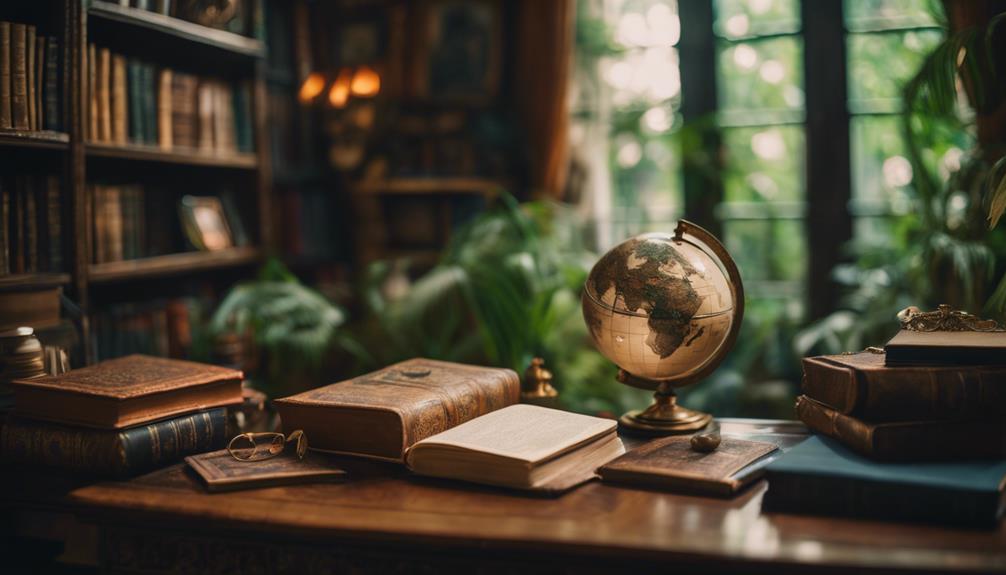
When you think about decorative elements in academic spaces, consider how framed vintage botanical prints, antique map wall tapestries, and antique hourglass display pieces can transform your environment.
These items not only enhance the aesthetic but also reflect a deep appreciation for knowledge and history.
Framed Vintage Botanical Prints
Framed vintage botanical prints bring a touch of nostalgia and nature into academic spaces, enhancing the overall aesthetic with their intricate designs and historical charm. These prints often showcase detailed illustrations of plants and flowers, reflecting the artistic styles of the 18th and 19th centuries.
By incorporating these prints into your decor, you create a serene atmosphere that promotes a connection to the natural world and the beauty of scholarly pursuits.
You can easily find framed botanical prints in antique shops, online marketplaces, or as reproductions, making them accessible and affordable options for personalizing your space. When you display these prints in cohesive arrangements, they complement other elements of academia aesthetics, such as bookshelves and vintage furniture, creating a harmonious and inviting environment.
Consider choosing prints that resonate with your personal style or academic interests. Whether you prefer soft pastels or bold colors, there's a botanical print that can elevate your space.
Antique Map Wall Tapestry
An antique map wall tapestry instantly transforms your academic space into a domain of exploration and historical intrigue. These stunning pieces not only serve as a fascinating focal point but also evoke a sense of curiosity that enhances your study environment. With their intricate designs and muted colors, they effortlessly align with aesthetics like Dark Academia and Light Academia, celebrating vintage elements that resonate with intellectual pursuits.
Incorporating an antique map tapestry can elevate the ambiance of your study or reading nook, creating a cozy and intellectually stimulating atmosphere. Whether you're diving into a historical novel or drafting your next essay, the tapestry's presence adds depth and character to your surroundings. Made from durable materials like cotton or polyester, these tapestries are designed to be both decorative and functional, ensuring they withstand the test of time in your living space.
Moreover, an antique map tapestry can spark engaging conversations about geography, history, and exploration, making it a perfect addition for a community of like-minded individuals. By choosing one, you're not just decorating; you're inviting stories and discussions into your space, enriching your academic experience.
Antique Hourglass Display Piece
Antique hourglass display pieces add a timeless charm to your academic space, symbolizing the passage of time while showcasing exquisite vintage craftsmanship. Made from materials like brass or wood, these hourglasses enhance the aesthetic appeal of your study area, fitting seamlessly into both light and dark academia themes.
The sand within the hourglass represents historical significance and intellectual pursuits, making it a thoughtful addition to your academic decor. Each piece comes in various sizes and designs, allowing you to personalize your space while infusing it with elegance and sophistication.
Incorporating an antique hourglass evokes a sense of nostalgia, reminding you of the pursuit of knowledge and the importance of time management in learning. It serves as a conversation starter, inviting reflections on the value of history and the wisdom it carries.
Whether you place it on your desk or a bookshelf, this decorative element can inspire a love for learning and elevate your environment. So, if you're looking to enhance your academic aesthetic, consider adding an antique hourglass to your collection. It's more than just decor; it's a symbol of your intellectual journey.
Flooring
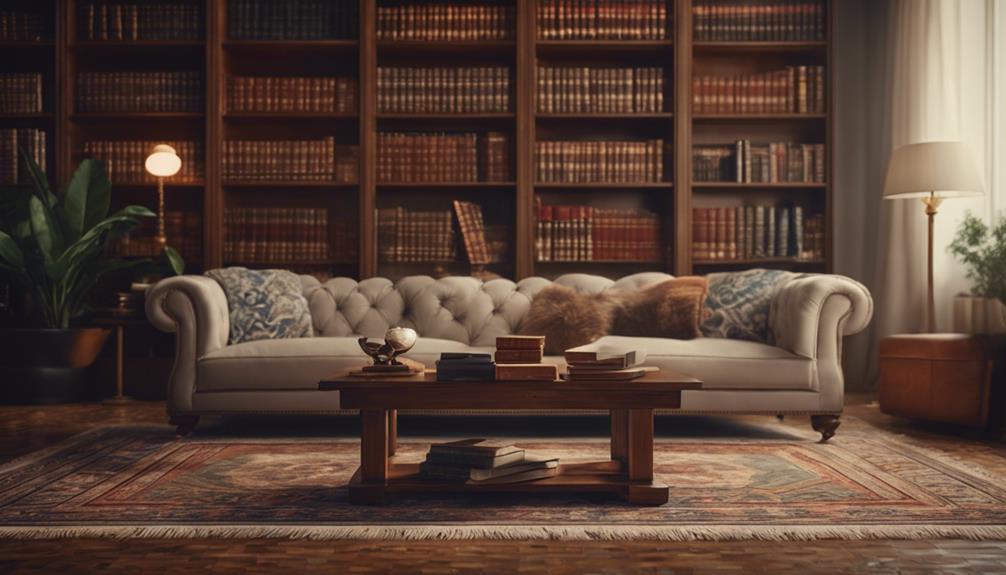
When you think about flooring in academia aesthetics, consider how your choices can set the tone for the entire space.
Dark-stained hardwood planks exude sophistication, while distressed vintage-style area rugs add warmth and character.
Polished marble tile flooring, on the other hand, brings a touch of elegance that can elevate any academic environment.
Dark-Stained Hardwood Planks
Dark-stained hardwood planks bring a rich, deep hue that instantly elevates the aesthetic of any space, making them a favorite in dark academia interiors. Crafted from durable hardwood species like oak, walnut, or hickory, they combine longevity with elegance. Their darker finish creates a striking contrast against lighter walls and furnishings, enhancing the vintage, scholarly vibe that defines dark academia.
When you choose dark-stained hardwood, you're not just selecting flooring; you're creating an environment that feels warm and inviting. This makes it ideal for study areas or artistic pursuits, essential components of the dark academia lifestyle. Regular maintenance, including sweeping and occasional refinishing, is key to preserving their luster and preventing scratches from becoming too noticeable.
Incorporating dark-stained hardwood planks into your space allows you to embrace a timeless aesthetic. Whether you're setting up a cozy reading nook or a sophisticated workspace, these planks provide a foundation that enriches your environment.
Distressed Vintage-Style Area Rugs
Distressed vintage-style area rugs add a layer of warmth and character to your space, perfectly complementing the scholarly vibe of both light and dark academia aesthetics. These rugs often feature muted colors and intricate patterns that evoke a sense of nostalgia, fitting seamlessly into your intellectual environment.
Made from durable materials like wool or cotton, these rugs guarantee comfort while maintaining a classic appearance. Their weathered look harmonizes beautifully with vintage furniture and decor, enhancing the overall aesthetic of your room and creating an inviting atmosphere.
When you're choosing a distressed vintage-style area rug, consider the size that best fits your space; a well-placed rug can serve as a focal point or grounding element among your books and artistic works.
Additionally, many of these rugs are designed with sustainability in mind, utilizing eco-friendly production methods and materials. This choice not only elevates your style but also contributes to an environmentally conscious home.
Polished Marble Tile Flooring
Polished marble tile flooring offers a luxurious touch that enhances the elegance of any academia-inspired space. Its renowned durability and stunning appearance make it a favorite choice for both light and dark academia aesthetics. The reflective surface of polished marble amplifies natural light, creating an inviting ambiance that beautifully complements vintage and classic decor styles.
You'll find polished marble tiles in various colors and patterns, allowing you to craft visually striking designs. Whether you prefer intricate mosaics or sleek, minimalist layouts, there's a marble option that aligns perfectly with your aesthetic vision.
However, maintaining polished marble flooring does require some effort. Regular cleaning and sealing are essential to preserve its shine and prevent stains, ensuring it remains a focal point in your space.
As a natural material, polished marble is eco-friendly and adds value to your property, making it a worthwhile investment for elevating your academic or artistic environment. By incorporating polished marble tile flooring, you not only enhance the beauty of your space but also create an atmosphere that inspires creativity and intellectual pursuit.
Conclusion
Now that you've explored the different types of academia aesthetics, it's time to find the one that truly reflects your personality. If you’re drawn to the timeless charm of vintage academia, consider incorporating bookshelves filled with leather-bound tomes and antique globes into your space. Alternatively, if you’re more inspired by the whimsical and eclectic, you might opt for an enchanting goblincore room decor featuring mystical trinkets, rustic furniture, and nature-inspired accents. Whatever your preference, let your academia aesthetic reflect your unique style and create a space that feels authentically you.
Whether you're drawn to the classic charm of vintage libraries or the sleek vibe of modern minimalism, mixing and matching elements can help you create a space that inspires you.
Don't hesitate to experiment with fixtures, lighting, and decor.
Your unique style is just waiting to be elevated, so go ahead and make it your own!

